Smart pH Sensing: A Self-Sensitivity Programmable Platform with Multi-Functional Charge-Trap-Flash ISFET Technology
Abstract
:1. Introduction
2. Materials and Methods
2.1. Fabrication of the Multi-Functional Charge-Trap-Flash-Type Field-Effect Transistor
2.2. Characterizations of the Self-Sensitivity Programmable pH Sensor Platform
2.3. Signal Amplification of the Self-Sensitivity Programmable pH Sensor Platform
3. Results and Discussion
3.1. Evaluation of the Multi-Functional Charge-Trap-Flash-Type Field-Effect Transistor
3.2. pH Sensing Characteristics of the Self-Sensitivity Programmable pH Sensor Platform
4. Conclusions
Author Contributions
Funding
Institutional Review Board Statement
Informed Consent Statement
Data Availability Statement
Acknowledgments
Conflicts of Interest
References
- Yager, P.; Domingo, G.J.; Gerdes, J. Point-of-Care Diagnostics for Global Health. Annu. Rev. Biomed. Eng. 2008, 10, 107–144. [Google Scholar] [CrossRef] [PubMed]
- Gubala, V.; Harris, L.F.; Ricco, A.J.; Tan, M.X.; Williams, D.E. Point of Care Diagnostics: Status and Future. Anal. Chem. 2012, 84, 487–515. [Google Scholar] [CrossRef] [PubMed]
- Biswas, G.C.; Choudhury, S.; Rabbani, M.M.; Das, J. A Review on Potential Electrochemical Point-of-Care Tests Targeting Pandemic Infectious Disease Detection: COVID-19 as a Reference. Chemosensors 2022, 10, 269. [Google Scholar] [CrossRef]
- Kumar, A.; Parihar, A.; Panda, U.; Parihar, D.S. Microfluidics-Based Point-of-Care Testing (POCT) Devices in Dealing with Waves of COVID-19 Pandemic: The Emerging Solution. ACS Appl. Bio Mater. 2021, 5, 2046–2068. [Google Scholar] [CrossRef] [PubMed]
- Goicoechea, J.; Zamarreño, C.R.; Matías, I.R.; Arregui, F.J. Optical Fiber PH Sensors Based on Layer-by-Layer Electrostatic Self-Assembled Neutral Red. Sens. Actuators B Chem. 2008, 132, 305–311. [Google Scholar] [CrossRef]
- Lin, J. Recent Development and Applications of Optical and Fiber-Optic PH Sensors. TrAC Trends Anal. Chem. 2000, 19, 541–552. [Google Scholar] [CrossRef]
- Szmacinski, H.; Lakowicz, J.R. Optical Measurements of PH Using Fluorescence Lifetimes and Phase-Modulation Fluorometry. Anal. Chem. 1993, 65, 1668–1674. [Google Scholar] [CrossRef] [PubMed]
- Qi, J.; Liu, D.; Liu, X.; Guan, S.; Shi, F.; Chang, H.; He, H.; Yang, G. Fluorescent PH Sensors for Broad-Range PH Measurement Based on a Single Fluorophore. Anal. Chem. 2015, 87, 5897–5904. [Google Scholar] [CrossRef]
- Pijanowska, D.G.; Torbicz, W. PH-ISFET Based Urea Biosensor. Sens. Actuators B Chem. 1997, 44, 370–376. [Google Scholar] [CrossRef]
- Cai, Q.; Zeng, K.; Ruan, C.; Desai, T.A.; Grimes, C.A. A Wireless, Remote Query Glucose Biosensor Based on a PH-Sensitive Polymer. Anal. Chem. 2004, 76, 4038–4043. [Google Scholar] [CrossRef]
- Moser, N.; Lande, T.S.; Toumazou, C.; Georgiou, P. ISFETs in CMOS and Emergent Trends in Instrumentation: A Review. IEEE Sens. J. 2016, 16, 6496–6514. [Google Scholar] [CrossRef]
- Douthwaite, M.; Moser, N.; Georgiou, P. CMOS ISFET Arrays for Integrated Electrochemical Sensing and Imaging Applications: A Tutorial. IEEE Sens. J. 2021, 21, 22155–22169. [Google Scholar] [CrossRef]
- Wong, H.S.; White, M.H. A Cmos-Integrated “Isfet-Operational Amplifier” Chemical Sensor Employing Differential Sensing. IEEE Trans. Electron Devices 1989, 36, 479–487. [Google Scholar] [CrossRef]
- Chan, W.P.; Premanode, B.; Toumazou, C. An Integrated ISFETs Instrumentation System in Standard CMOS Technology. IEEE J. Solid-State Circuits 2010, 45, 1923–1934. [Google Scholar] [CrossRef]
- Bergveld, P. The Operation of an ISFET as an Electronic Device. Sens. Actuators 1981, 1, 17–29. [Google Scholar] [CrossRef]
- Knopfmacher, O.; Tarasov, A.; Fu, W.; Wipf, M.; Niesen, B.; Calame, M.; Schönenberger, C. Nernst Limit in Dual-Gated Si-Nanowire FET Sensors. Nano Lett. 2010, 10, 2268–2274. [Google Scholar] [CrossRef] [PubMed]
- Bergveld, P. Thirty Years of ISFETOLOGY: What Happened in the Past 30 Years and What May Happen in the next 30 Years. Sens. Actuators B Chem. 2003, 88, 1–20. [Google Scholar] [CrossRef]
- Cho, S.-K.; Cho, W.-J. High-Sensitivity PH Sensor Based on Coplanar Gate AlGaN/GaN Metal-Oxide-Semiconductor High Electron Mobility Transistor. Chemosensors 2021, 9, 42. [Google Scholar] [CrossRef]
- Shojaei Baghini, M.; Vilouras, A.; Douthwaite, M.; Georgiou, P.; Dahiya, R. Ultra-Thin ISFET-Based Sensing Systems. Electrochem. Sci. Adv. 2022, 2, e2100202. [Google Scholar] [CrossRef]
- Ahn, J.H.; Kim, J.Y.; Seol, M.L.; Baek, D.J.; Guo, Z.; Kim, C.H.; Choi, S.J.; Choi, Y.K. A PH Sensor with a Double-Gate Silicon Nanowire Field-Effect Transistor. Appl. Phys. Lett. 2013, 102, 83701. [Google Scholar] [CrossRef]
- Livingstone, A.W.; Welbourn, A.D.; Blau, G.L. Manufacturing Tolerance of Capacitor Coupled GaAs FET Logic Circuits. IEEE Electron Device Lett. 1982, 3, 284–285. [Google Scholar] [CrossRef]
- Xu, C.; Banerjee, K. Physical Modeling of the Capacitance and Capacitive Coupling Noise of through-Oxide vias in FDSOI-Based Ultra-High Density 3-D ICs. IEEE Trans. Electron Devices 2013, 60, 123–131. [Google Scholar] [CrossRef]
- Shin, K.; Kang, D.S.; Lee, S.H.; Moon, W. A Scanning Microscopy Technique Based on Capacitive Coupling with a Field-Effect Transistor Integrated with the Tip. Ultramicroscopy 2015, 159, 1–10. [Google Scholar] [CrossRef]
- Jang, K.H.; Jang, H.J.; Park, J.K.; Cho, W.J. Self-Amplified Dual Gate Charge Trap Flash Memory for Low-Voltage Operation. IEEE Electron Device Lett. 2013, 34, 756–758. [Google Scholar] [CrossRef]
- Ahn, M.J.; Cho, W.J. Dual-Gate Charge Trap Flash Memory for Highly Reliable Triple Level Cell Using Capacitive Coupling Effects. IEEE Electron Device Lett. 2017, 38, 36–39. [Google Scholar] [CrossRef]
- Kim, M.; Park, E.; Kim, I.S.; Park, J.; Kim, J.; Jeong, Y.; Lee, S.; Kim, I.; Park, J.K.; Seong, T.Y.; et al. A Comparison Study on Multilayered Barrier Oxide Structure in Charge Trap Flash for Synaptic Operation. Crystals 2021, 11, 70. [Google Scholar] [CrossRef]
- Yin, L.T.; Chou, J.C.; Chung, W.Y.; Sun, T.P.; Hsiung, S.K. Separate Structure Extended Gate H+-Ion Sensitive Field Effect Transistor on a Glass Substrate. Sens. Actuators B Chem. 2000, 71, 106–111. [Google Scholar] [CrossRef]
- Chi, L.L.; Chou, J.C.; Chung, W.Y.; Sun, T.P.; Hsiung, S.K. Study on Extended Gate Field Effect Transistor with Tin Oxide Sensing Membrane. Mater. Chem. Phys. 2000, 63, 19–23. [Google Scholar] [CrossRef]
- Yin, L.T.; Chou, J.C.; Chung, W.Y.; Sun, T.P.; Hsiung, S.K. Study of Indium Tin Oxide Thin Film for Separative Extended Gate ISFET. Mater. Chem. Phys. 2001, 70, 12–16. [Google Scholar] [CrossRef]
- Chou, J.C.; Wang, Y.F. Preparation and Study on the Drift and Hysteresis Properties of the Tin Oxide Gate ISFET by the Sol–Gel Method. Sens. Actuators B Chem. 2002, 86, 58–62. [Google Scholar] [CrossRef]
- Tsai, C.N.; Chou, J.C.; Sun, T.P.; Hsiung, S.K. Study on the Sensing Characteristics and Hysteresis Effect of the Tin Oxide PH Electrode. Sens. Actuators B Chem. 2005, 108, 877–882. [Google Scholar] [CrossRef]
- Jamasb, S. An Analytical Technique for Counteracting Drift in Ion-Selective Field Effect Transistors (ISFETs). IEEE Sens. J. 2004, 4, 795–801. [Google Scholar] [CrossRef]
- Chen, D.Y.; Chan, P.K. An Intelligent ISFET Sensory System with Temperature and Drift Compensation for Long-Term Monitoring. IEEE Sens. J. 2008, 8, 1948–1959. [Google Scholar] [CrossRef]
- Bousse, L.; van den Vlekkert, H.H.; de Rooij, N.F. Hysteresis in Al2O3-Gate ISFETs. Sens. Actuators B Chem. 1990, 2, 103–110. [Google Scholar] [CrossRef]
- Trinh, T.T.; Nguyen, V.D.; Ryu, K.; Jang, K.; Lee, W.; Baek, S.; Raja, J.; Yi, J. Improvement in the Performance of an InGaZnO Thin-Film Transistor by Controlling Interface Trap Densities between the Insulator and Active Layer. Semicond. Sci. Technol. 2011, 26, 085012. [Google Scholar] [CrossRef]
- Du, H.; Lin, X.; Xu, Z.; Chu, D. Electric Double-Layer Transistors: A Review of Recent Progress. J. Mater. Sci. 2015, 50, 5641–5673. [Google Scholar] [CrossRef]
- Lee, D.H.; Park, H.; Cho, W.J. Advancements in Complementary Metal-Oxide Semiconductor-Compatible Tunnel Barrier Engineered Charge-Trapping Synaptic Transistors for Bio-Inspired Neural Networks in Harsh Environments. Biomimetics 2023, 8, 506. [Google Scholar] [CrossRef]
- Baik, S.J.; Shin, H. Charge Trapping in Amorphous Dielectrics for Secure Charge Storage. ACS Appl. Mater. Interfaces 2021, 13, 11507–11514. [Google Scholar] [CrossRef]
- Hota, M.K.; Alshammari, F.H.; Salama, K.N.; Alshareef, H.N. Transparent Flash Memory Using Single Ta2O5 Layer for Both Charge-Trapping and Tunneling Dielectrics. ACS Appl. Mater. Interfaces 2017, 9, 21856–21863. [Google Scholar] [CrossRef]
- Nakata, S.; Saito, K.; Shimada, M. Non-Volatile Al2O3 Memory Using Nanoscale Al-Rich Al2O3 Thin Film as a Charge Storage Layer. Jpn. J. Appl. Phys. Part 1 Regul. Pap. Short. Notes Rev. Pap. 2006, 45, 3176–3178. [Google Scholar] [CrossRef]
- Lee, D.J.; Yim, S.S.; Kim, K.S.; Kim, S.H.; Kim, K.B. Nonvolatile Memory Characteristics of Atomic Layer Deposited Ru Nanocrystals with a SiO2/Al2O3 Bilayered Tunnel Barrier. J. Appl. Phys. 2010, 107, 13707. [Google Scholar] [CrossRef]
- Kim, H.J.; Cha, S.Y.; Choi, D.J. Memory Characteristics of Al2O3/La2O3/Al2O3 Multi-Layer Films with Various Blocking and Tunnel Oxide Thicknesses. Mater. Sci. Semicond. Process 2010, 13, 9–12. [Google Scholar] [CrossRef]
- Zhu, W.J.; Ma, T.P.; Zafar, S.; Tamagawa, T. Charge Trapping in Ultrathin Hafnium Oxide. IEEE Electron Device Lett. 2002, 23, 597–599. [Google Scholar] [CrossRef]
- Maikap, S.; Lee, H.Y.; Wang, T.Y.; Tzeng, P.J.; Wang, C.C.; Lee, L.S.; Liu, K.C.; Yang, J.R.; Tsai, M.J. Charge Trapping Characteristics of Atomic-Layer-Deposited HfO2 Films with Al2O3 as a Blocking Oxide for High-Density Non-Volatile Memory Device Applications. Semicond. Sci. Technol. 2007, 22, 884. [Google Scholar] [CrossRef]
- Song, Y.S.; Song, Y.S.; Jang, T.; Min, K.K.; Baek, M.H.; Yu, J.; Kim, Y.; Lee, J.H.; Park, B.G. Tunneling Oxide Engineering for Improving Retention in Nonvolatile Charge-Trapping Memory with TaN/Al2O3/HfO2/SiO2/Al2O3/SiO2/Si Structure. Jpn. J. Appl. Phys. 2020, 59, 061006. [Google Scholar] [CrossRef]
- Yoo, J.H.; Park, W.J.; Kim, S.W.; Lee, G.R.; Kim, J.H.; Lee, J.H.; Uhm, S.H.; Lee, H.C. Preparation of Remote Plasma Atomic Layer-Deposited HfO2 Thin Films with High Charge Trapping Densities and Their Application in Nonvolatile Memory Devices. Nanomaterials 2023, 13, 1785. [Google Scholar] [CrossRef]
- Yoon, G.; Kim, T.; Agrawal, K.; Kim, J.; Park, J.; Kim, H.-H.; Cho, E.-C.; Yi, J. Optimization of MIS Type Non-Volatile Memory Device with Al-Doped HfO2 as Charge Trapping Layer. ECS J. Solid State Sci. Technol. 2020, 9, 075004. [Google Scholar] [CrossRef]
- Govoreanu, B.; Blomme, P.; Rosmeulen, M.; Van Houdt, J.; De Meyer, K. Variot: A Novel Multilayer Tunnel Barrier Concept for Low-Voltage Nonvolatile Memory Devices. IEEE Electron Device Lett. 2003, 24, 99–101. [Google Scholar] [CrossRef]
- Spitzer, A.; Baunach, R. The Physics of ONO Layer Dielectrics. Appl. Surf. Sci. 1989, 39, 192–199. [Google Scholar] [CrossRef]
- Golubović, D.S.; Vianello, E.; Arreghini, A.; Driussi, F.; Van Duuren, M.J.; Akil, N.; Selmi, L.; Esseni, D. Programme and Retention Characteristics of SONOS Memory Arrays with Layered Tunnel Barrier. Semicond. Sci. Technol. 2008, 23, 075003. [Google Scholar] [CrossRef]
- Lu, C.Y.; Hsieh, K.Y.; Liu, R. Future Challenges of Flash Memory Technologies. Microelectron. Eng. 2009, 86, 283–286. [Google Scholar] [CrossRef]
- Mori, S.; Sakagami, E.; Araki, H.; Kaneko, Y.; Narita, K.; Ohshima, Y.; Yoshikawa, K.; Arai, N. ONO Inter-Poly Dielectric Scaling for Nonvolatile Memory Applications. IEEE Trans. Electron Devices 1991, 38, 386–391. [Google Scholar] [CrossRef]
- Boutchich, M.; Golubović, D.S.; Akil, N.; van Duuren, M. Evaluation of Layered Tunnel Barrier Charge Trapping Devices for Embedded Non-Volatile Memories. Microelectron. Eng. 2010, 87, 41–46. [Google Scholar] [CrossRef]
- Mori, S.; Araki, Y.Y.; Sato, M.; Meguro, H.; Tsunoda, H.; Kamiya, E.; Yoshikawa, K.; Arai, N.; Sakagami, E. Thickness Scaling Limitation Factors of ONO Interpoly Dielectric for Nonvolatile Memory Devices. IEEE Trans. Electron Devices 1996, 43, 47–53. [Google Scholar] [CrossRef]
- Kobayashi, K.; Miyatake, H.; Hirayama, M.; Higaki, T.; Abe, H. Dielectric Breakdown and Current Conduction of Oxide/Nitride/Oxide Multi-Layer Structures. J. Electrochem. Soc. 1992, 139, 1693–1699. [Google Scholar] [CrossRef]
- Mori, S.; Kaneko, Y.; Yoshikawa, K.; Arai, N. Polyoxide Thinning Limitation and Superior ONO Interpoly Dielectric for Nonvolatile Memory Devices. IEEE Trans. Electron Devices 1991, 38, 270–277. [Google Scholar] [CrossRef]
- Mielke, N.; Belgal, H.; Kalastirsky, I.; Kalavade, P.; Kurtz, A.; Meng, Q.; Righos, N.; Wu, J. Flash EEPROM Threshold Instabilities Due to Charge Trapping during Program/Erase Cycling. IEEE Trans. Device Mater. Reliab. 2004, 4, 335–343. [Google Scholar] [CrossRef]
- Min, J.; Ronchi, N.; McMitchell, S.R.C.; OrSullivan, B.; Banerjee, K.; Van den Bosch, G.; Van Houdt, J.; Shin, C. Program/Erase Scheme for Suppressing Interface Trap Generation in HfO2-Based Ferroelectric Field Effect Transistor. IEEE Electron Device Lett. 2021, 42, 1280–1283. [Google Scholar] [CrossRef]
- Kim, D.H.; Park, B.G. Program/Erase Model of NAND-Type Nitride-Based Charge Trapping Flash Memories. In Proceedings of the IEEE 2008 Silicon Nanoelectronics Workshop, Honolulu, HI, USA, 15–16 June 2008. [Google Scholar] [CrossRef]
- Kim, S.J.; Lee, S.Y.; Lee, Y.W.; Kuk, S.H.; Kwon, J.Y.; Han, M.K. Effect of Charge Trapping/Detrapping on Threshold Voltage Shift of IGZO TFTs under AC Bias Stress. Electrochem. Solid-State Lett. 2012, 15, H108–H110. [Google Scholar] [CrossRef]
- Zafar, S.; Callegari, A.; Gusev, E.; Fischetti, M.V. Charge Trapping Related Threshold Voltage Instabilities in High Permittivity Gate Dielectric Stacks. J. Appl. Phys. 2003, 93, 9298–9303. [Google Scholar] [CrossRef]
- Zafar, S.; Callegari, A.; Gusev, E.; Fischetti, M.V. Charge Trapping in High K Gate Dielectric Stacks. Tech. Dig. Int. Electron Devices Meet. 2002, 517–520. [Google Scholar] [CrossRef]
- Liu, J.; Jaiyen, B.; Kim, Y.; Wilkerson, C.; Mutlu, O. MutluOnur An Experimental Study of Data Retention Behavior in Modern DRAM Devices. ACM SIGARCH Comput. Archit. News 2013, 41, 60–71. [Google Scholar] [CrossRef]
- Tao, G.; Scarpa, A.; Dijkstra, J.; Stidl, W.; Kuper, F. Data Retention Prediction for Modern Floating Gate Non-Volatile Memories. Microelectron. Reliab. 2000, 40, 1561–1566. [Google Scholar] [CrossRef]
- Krieger, J.H.; Spitzer, S.M. Non-Traditional, Non-Volatile Memory Based on Switching and Retention Phenomena in Polymeric Thin Films. In Proceedings of the 2004 Non-Volatile Memory Technology Symposium, NVMTS, Orlando, FL, USA, 17 November 2004; pp. 121–124. [Google Scholar] [CrossRef]
- Jamasb, S.; Collins, S.; Smith, R.L. A Physical Model for Drift in PH ISFETs. Sens. Actuators B Chem. 1998, 49, 146–155. [Google Scholar] [CrossRef]
- Chou, J.C.; Weng, C.Y. Sensitivity and Hysteresis Effect in Al2O3 Gate PH-ISFET. Mater. Chem. Phys. 2001, 71, 120–124. [Google Scholar] [CrossRef]
- Chiang, J.L.; Jan, S.S.; Chou, J.C.; Chen, Y.C. Study on the Temperature Effect, Hysteresis and Drift of PH-ISFET Devices Based on Amorphous Tungsten Oxide. Sens. Actuators B Chem. 2001, 76, 624–628. [Google Scholar] [CrossRef]
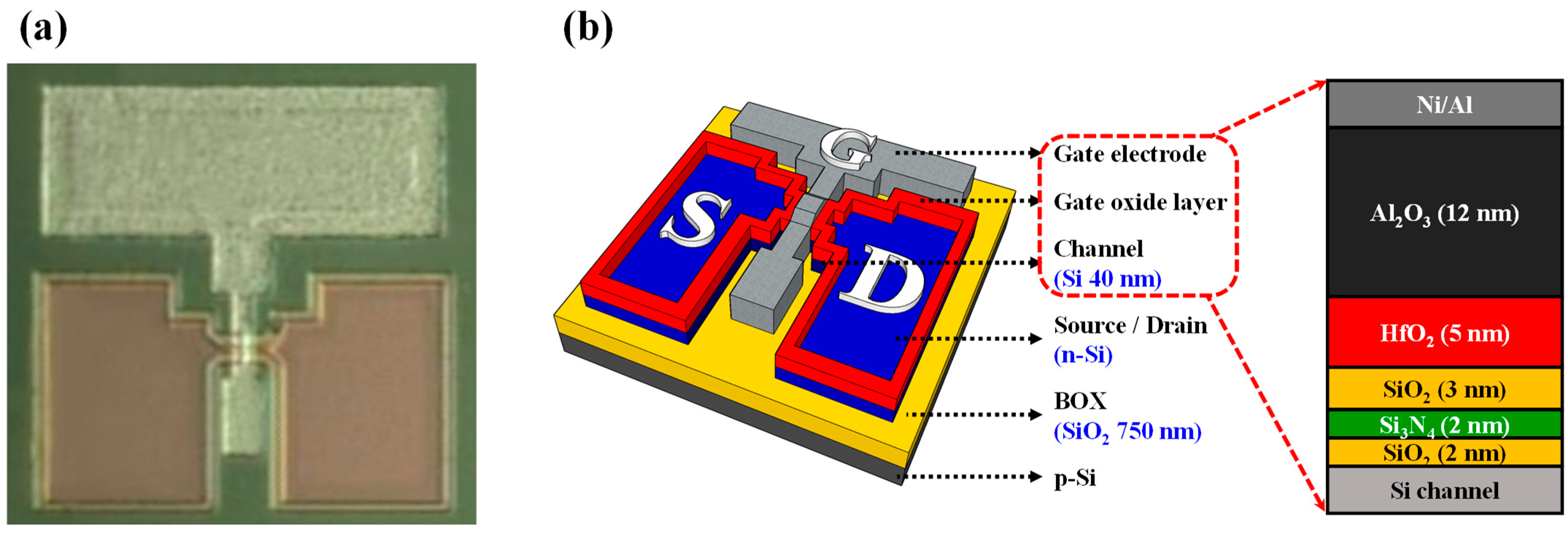
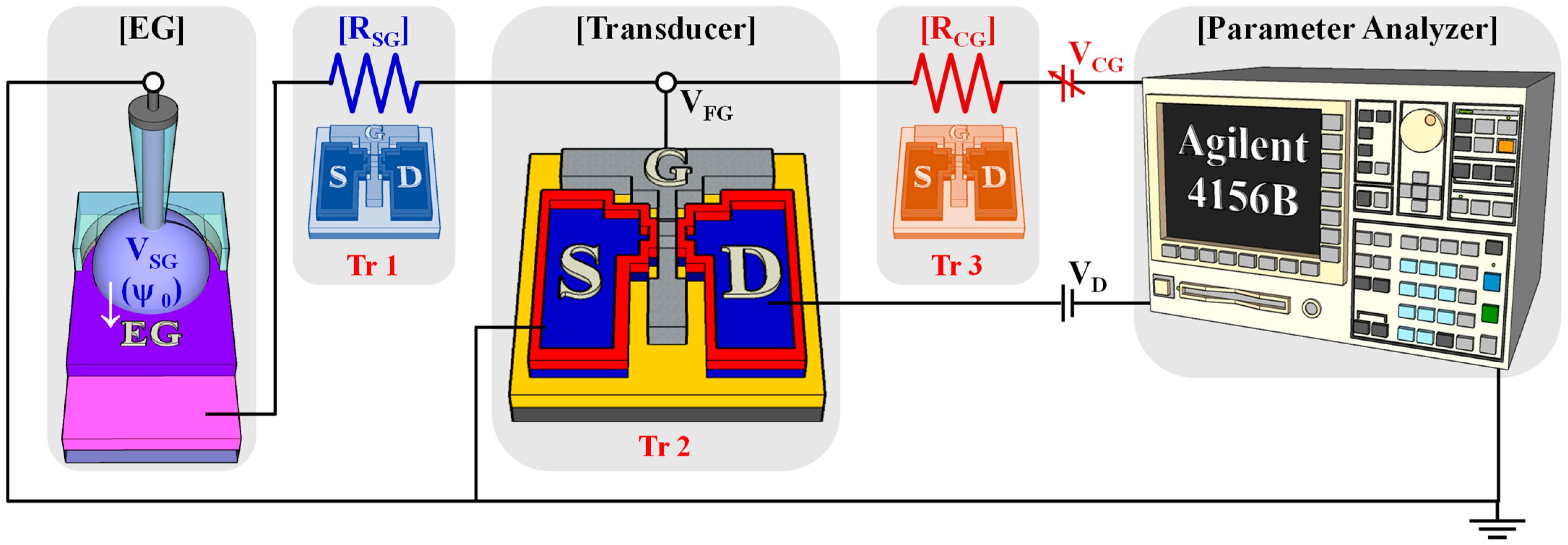
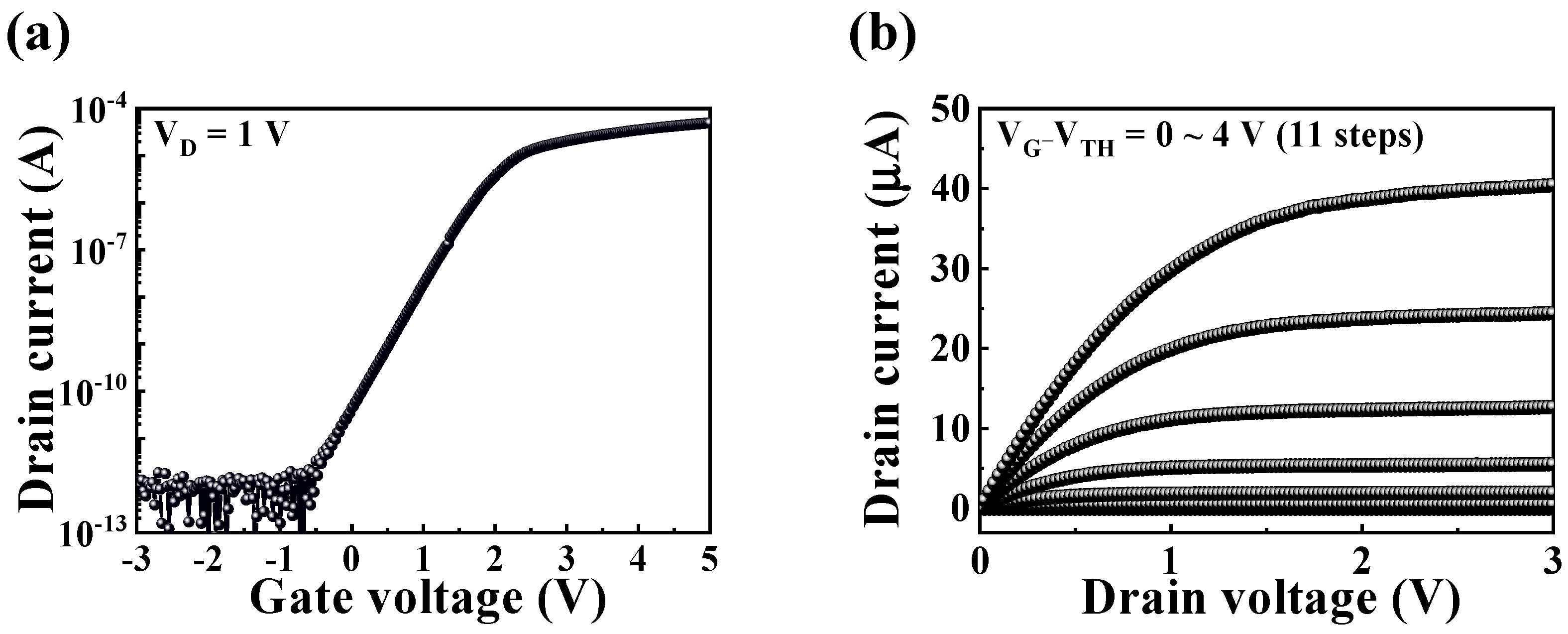





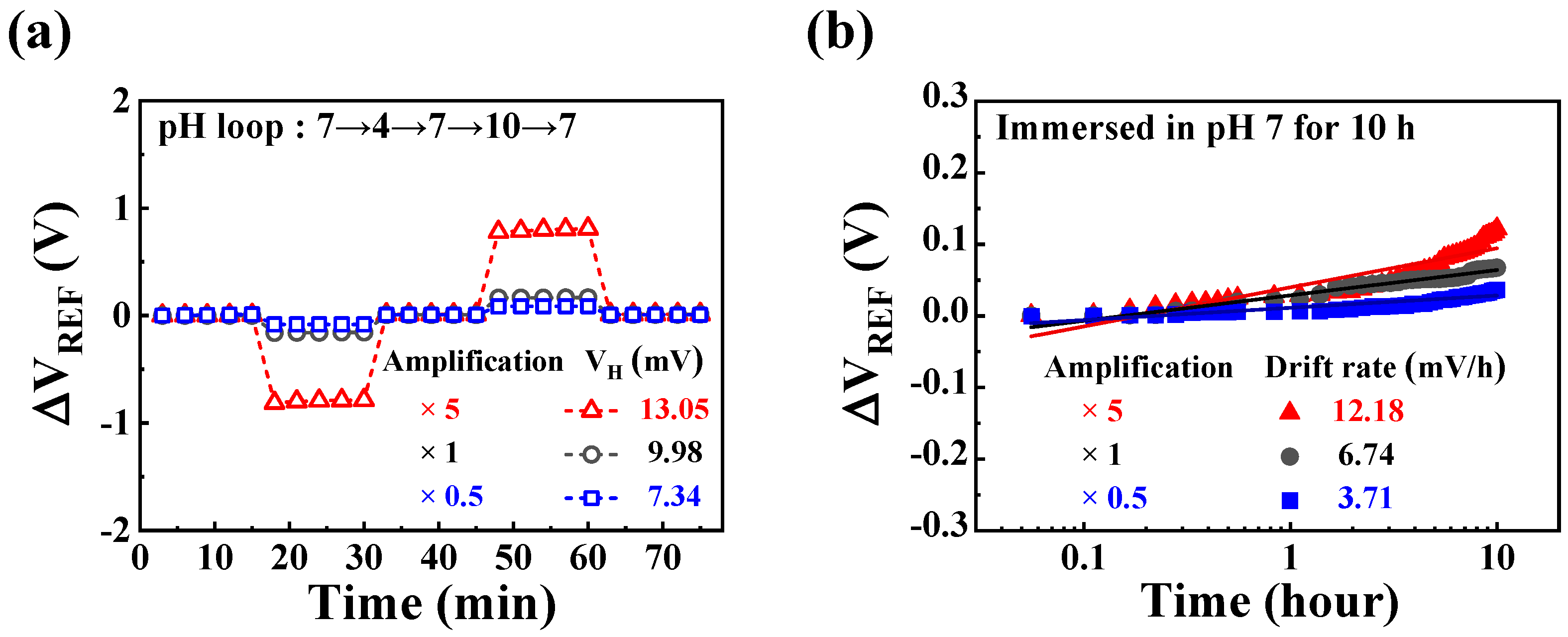
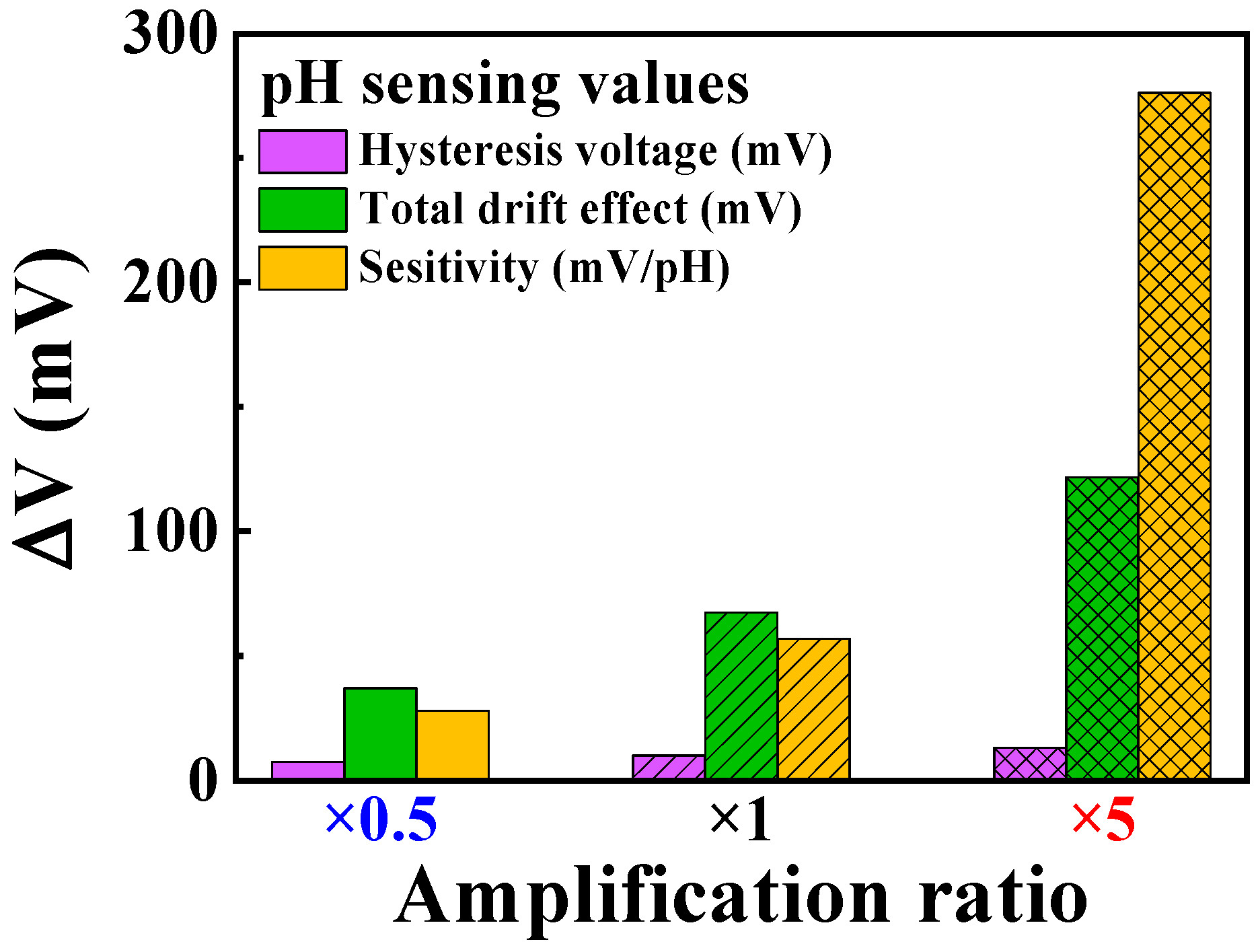
| VTH (V) | SS (mV/dec) | μFE (cm2/V·s) | Ion/Ioff (A/A) |
|---|---|---|---|
| −0.25 | 175.54 | 234.92 | 1.49 × 107 |
| Amplification Ratio | Hysteresis Voltage (mV) | Drift Rate (mV/h) | Sensitivity (mV/pH) |
|---|---|---|---|
| ×0.5 | 7.34 | 3.71 | 28.02 |
| ×1 | 9.98 | 6.74 | 56.96 |
| ×5 | 13.05 | 12.18 | 276.06 |
Disclaimer/Publisher’s Note: The statements, opinions and data contained in all publications are solely those of the individual author(s) and contributor(s) and not of MDPI and/or the editor(s). MDPI and/or the editor(s) disclaim responsibility for any injury to people or property resulting from any ideas, methods, instructions or products referred to in the content. |
© 2024 by the authors. Licensee MDPI, Basel, Switzerland. This article is an open access article distributed under the terms and conditions of the Creative Commons Attribution (CC BY) license (https://creativecommons.org/licenses/by/4.0/).
Share and Cite
Kim, Y.-U.; Cho, W.-J. Smart pH Sensing: A Self-Sensitivity Programmable Platform with Multi-Functional Charge-Trap-Flash ISFET Technology. Sensors 2024, 24, 1017. https://doi.org/10.3390/s24031017
Kim Y-U, Cho W-J. Smart pH Sensing: A Self-Sensitivity Programmable Platform with Multi-Functional Charge-Trap-Flash ISFET Technology. Sensors. 2024; 24(3):1017. https://doi.org/10.3390/s24031017
Chicago/Turabian StyleKim, Yeong-Ung, and Won-Ju Cho. 2024. "Smart pH Sensing: A Self-Sensitivity Programmable Platform with Multi-Functional Charge-Trap-Flash ISFET Technology" Sensors 24, no. 3: 1017. https://doi.org/10.3390/s24031017





